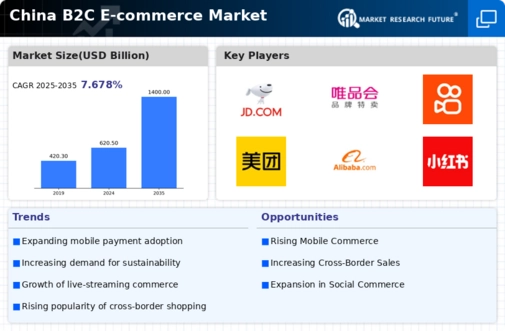The China B2C E-commerce Market is a dynamic and rapidly evolving landscape that showcases an array of competitive players vying for consumer attention. This market has experienced unprecedented growth fueled by increasing internet penetration, mobile device usage, and changing consumer spending habits.
A robust digital infrastructure has allowed new entrants and established players to flourish, each vying for their share of the consumer market. This environment is characterized by diverse business models and strategies tailored to capture the hearts and wallets of Chinese consumers, who are known for their sophistication and demand for quality and innovation in online retail.
Companies are continually innovating, refining their supply chains, enhancing customer experiences, and adopting advanced technologies to stay ahead of competitors. The competitive nature of this market is ongoing, driven by the need for agility and adaptability in response to ever-changing consumer preferences and technological advancements.
Weidian has carved out a formidable presence in the China B2C E-commerce landscape by leveraging social commerce strategies and a user-friendly interface that appeals to small entrepreneurs and individual sellers. Weidian's marketplace allows users to set up shops without any complex steps, thus democratizing the e-commerce space for a wide array of sellers.
This accessibility has positioned Weidian favorably among those seeking to enter online retail with minimal investment. Its strengths lie in its robust community features that facilitate easier customer engagement and interactions, as well as integration with social media platforms that allow sellers to tap into their personal networks for promotion.
Weidian not only provides a platform for sales but also fosters a unique ecosystem where personal branding and community-building are crucial elements, enhancing customer loyalty and the overall shopping experience.
JD.com stands as one of the largest and most well-known B2C e-commerce platforms in China, showcasing a strong commitment to quality and efficiency. The company is noted for its comprehensive range of products, from electronics to apparel, ensuring that it caters to diverse consumer needs.
JD.com emphasizes a solid logistics network, which allows for rapid delivery, a significant strength that enhances customer satisfaction and maintains its competitive edge. The company has invested significantly in technology, including artificial intelligence and data analytics, to streamline operations and optimize inventory management.
Mergers and acquisitions have also been part of JD.com's strategy, enhancing its capabilities and market reach. Through collaborations and partnerships within the technology and retail sectors, JD.com continues to innovate and reinforce its market presence in the competitive landscape of China's B2C e-commerce industry, ensuring it remains a formidable player in the ever-evolving consumer market.



















Leave a Comment